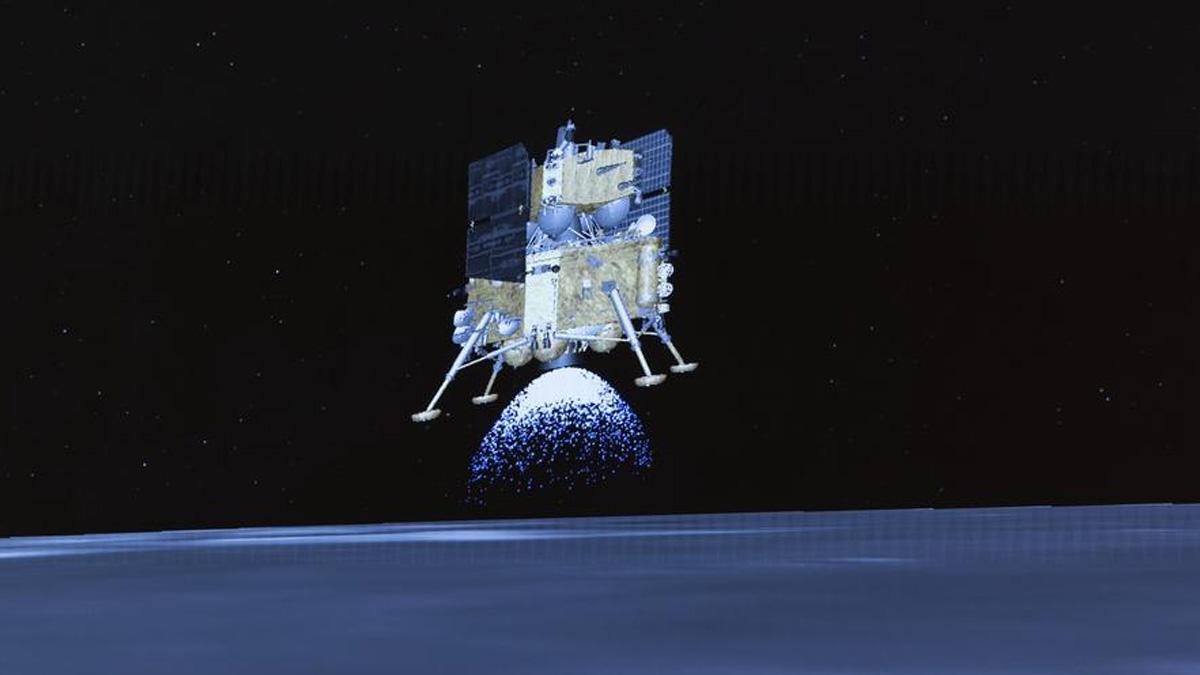China's newest lunar mission, Chang'e-6, made history on Sunday as it landed on the far side of the Moon, marking the beginning of the first-ever collection of samples from this little-explored area in human history, said the China National Space Administration (CNSA).
With the support of the relay satellite Queqiao-2, the lander-ascender pair of the Chang'e-6 probe completed a precise touchdown at 6:23 a.m. Beijing Time in the South Pole-Aitken Basin, according to Xinhua news agency.
Chang'e-6, consisting of an orbiter, a returner, a lander, and an ascender, took to space on May 3 and went through a series of procedures that included Earth-Moon transfer, near-Moon braking, lunar orbiting, and landing descent.
With the support of the relay satellite Queqiao-2, the lander-ascender pair of the Chang'e-6 probe completed a precise touchdown at 6:23 a.m. Beijing Time in the South Pole-Aitken Basin, according to Xinhua news agency.
Chang'e-6, consisting of an orbiter, a returner, a lander, and an ascender, took to space on May 3 and went through a series of procedures that included Earth-Moon transfer, near-Moon braking, lunar orbiting, and landing descent. The separation of the lander-ascender pair from the orbiter-returner combination occurred on May 30, as disclosed by the CNSA.
The descent of the lander-ascender commenced at 6:09 a.m., utilizing a main engine with variable thrust to maneuver and gradually approach the lunar surface. An autonomous visual obstacle avoidance system was engaged during the descent, employing a visible light camera to select a secure landing area based on lunar surface brightness and darkness.
Upon reaching approximately 100 meters above the designated landing spot, the combination employed a laser 3D scanner to detect surface obstacles, facilitating the final selection of the landing site before a controlled vertical descent. Safely touching down via free fall, cushioned by a protective system, marked the culmination of this intricate landing procedure.
Chang'e-6's primary objective is to retrieve and transport samples from the moon's far side, a pioneering feat in human lunar exploration. This mission aims to advance lunar retrograde orbit design and control technology while demonstrating key capabilities in intelligent and rapid sampling, as well as takeoff and ascent from the far side of the moon.
The chosen landing site, the Apollo Basin within the SPA Basin, was selected for its scientific exploration potential and favorable landing conditions, including communication and telemetry capabilities, as explained by Huang Hao, a space expert from the China Aerospace Science and Technology Corporation (CASC). Despite the rugged terrain of the far side, the relatively flat terrain of the Apollo Basin facilitates safe landing operations.
Equipped with a suite of sensors including microwave, laser, and optical imaging sensors, the lander ensures precise distance and speed measurement and obstacle detection on the lunar surface. Additional gamma-ray sensors mitigate optical sensor interference from lunar dust, aiding in accurate height measurement during landing.
Following landing, the probe is slated to complete sampling within two days, employing drilling and robotic arm techniques to collect subsurface and surface samples, respectively. To streamline the sampling process, the development team has established a simulation lab to simulate the lunar environment and validate sampling strategies and equipment control procedures.
Due to communication limitations on the far side of the moon, Chang'e-6's sampling time is reduced to approximately 14 hours compared to its predecessor Chang'e-5. To optimize efficiency, the development team has enhanced the probe's autonomy, enabling it to execute instructions and make judgments independently, thus minimizing Earth-moon interactions and reducing the number of ground control commands required.
With Chang'e-6 poised to embark on this historic sampling mission, it represents another significant leap forward in China's lunar exploration endeavors, promising valuable insights into the mysteries of the moon's far side.
Read Also | China's Historic Lunar Probe Mission: Collecting Samples from the Far Side of the Moon
Read Also | Innovative India: Pioneering COVID Vaccines and Lunar Exploration, Says Jaishankar


















